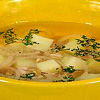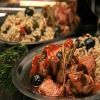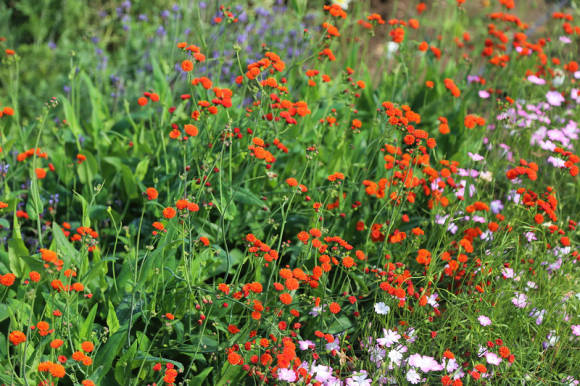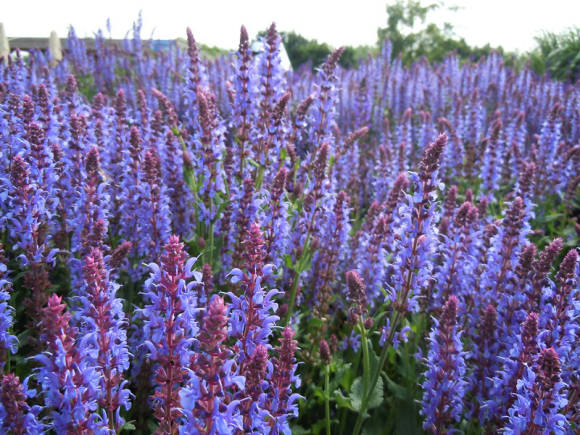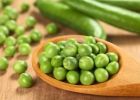What kind of currants to plant? The specialist cannot answer unequivocally. Let's try to figure out where the currant will grow, which variety to choose, and who needs to think about whether to grow it.
 |
The currant is unpretentious, grows even on poor soils and is widespread throughout temperate zones. It does not tolerate stagnant moisture, since it has a surface root system that decays with shallow groundwater, closer than 1 m.In waterlogged areas with a disturbed structure and air permeability, for a long time flooded with melt and rainwater, currants will not grow. In addition to swampy, heavy, stony and sandy soils, as well as with high acidity, are unsuitable for cultivation. It is desirable that the soil is still fertile, otherwise the growth activity and fruiting of currants will be low.
Many gardeners believe that currants tolerate shading and are planted under fruit trees or near fences and buildings. But with a lack of sunlight, her growth is weakened, the yield and quality of berries decreases, and the susceptibility to diseases increases sharply.
Currant plants, with the exception of golden currant, even when irrigated, do not withstand prolonged heat and drought, as well as strong winds during the growing season. On the surface of currant leaves there are microscopic stomata, which are responsible for saturating plants with oxygen and moisture. Under unfavorable weather conditions, the stomata close, physiological processes are disrupted, photosynthesis stops, and the plants dry up.
Golden currants have small leaves with a dense surface layer, so it is cultivated in areas with a hot climate, where other currants will not grow. Possessing high resistance not only to drought, but also to frost, as well as vigorous growth, golden currant grows into an impassable hedge in a couple of years.
 |  |
In Central Russia, golden currant is used mainly as an ornamental shrub. The yield of this culture is low, the berries have a specific taste and pubescence, and the plants themselves take up a lot of space, so they are rarely found on personal plots.
The limiting factor in the cultivation of black and red currants is the instability of plants to a number of pathogens and pests. Fighting them is a troublesome and often dangerous business due to the use of chemicals, therefore, it is necessary to select resistant varieties, to carry out agrotechnical measures in a timely manner and not to acquire seedlings in random places.
Precautions will not help if there are diseased bushes in neighboring areas damaged by the most dangerous pest, the currant bud mite. In addition to the harmfulness, in the form of a violation of the development of the kidneys, this pest carries a dangerous viral disease - the doubleness (reversion) of currants, due to which fruiting stops. There are no immune varieties to this scourge, as well as means of struggle, therefore, compliance with the rules and spatial isolation will not help when there is an aggressive infectious background nearby. Infection of healthy plants is only a matter of time.
Growing currants next to conifers can be fatal. The history of the centuries-old dramatic interaction of these cultures, according to foreign sources, is as follows. During the development of America, in the middle of the 17th century, the enterprising Englishman Weymouth drew attention to the powerful, 30-40 m high, North American pines, which could be used in shipbuilding. He brought the seedlings to England and, to hide their "colonial" origin, called them Weymouth pine.
Plants quickly spread and began to compete with the local Scots pine.Years later, large forest owners through parliament were able to achieve a ban on the industrial cultivation of Weymouth pine in England and the expulsion of the remaining trees to their "historical homeland", which was done at the end of the 18th century.
In those days, they did not know that these plants could be carriers of spores of a harmful disease, so a type of blister rust that had never been found before came to North America and spread. Intermediate host plants of this pathogen are currants, gooseberries and sedges. Therefore, their placement next to conifers, especially five-conifers (5 needles grow from one point), to which the Weymouth pine belongs, is unsafe.
If rust causes significant harm to currant and gooseberry plants in the so-called epiphytotic years, then for some conifers it is destructive, regardless of conditions. In a matter of decades, almost all relict North American pines in the United States were struck and died from blistering rust. When the situation was clarified at the beginning of the 20th century, the authorities imposed a ban on the cultivation of currants and gooseberries. During the Great Depression, up to 10 thousand people were involved in the destruction of currant and gooseberry plants within a radius of 1 km from growing pines. Only in 1966, with the advent of resistant varieties and chemical remedies, the ban on cultivation in some states was lifted, but currants and gooseberries never regained their former positions in food culture, although they were previously very popular. More than one generation of Americans has grown up, unable to eat wild-growing or self-grown currant berries, which are so available to most Russians.
In the modern realities of the domestic dacha and backyard farming, much depends on the priorities set by their owners. If the soil and climatic, phytosanitary conditions are not favorable, or if landscape design is interesting using conifers and plants for reservoirs, it is better not to plant currants.
If you want to get berries, and having the opportunity to grow them, having coordinated plans with the main consumers of vitamin products, you should decide on the choice of varieties, but before that it is sensible to assess your own strengths. If you plan to meet the needs of the family and have time to process the crop, it is enough to have 3-4 black currant bushes, 2 red currants on the site, and for lovers of dessert berries - still white or pink currants. If you plan to grow berries for sale, the number of plants on the site should be such that you can comfortably place them, use them, and sell the berries.
 |
To extend the period of consumption of fresh berries, and in order not to engage in emergency processing or attachment, it is better to choose varieties of different ripening periods from early to late.
Blackcurrant berries, like other parts of it, depending on the variety, have a currant aroma of varying intensity. This is the smell of essential oils that produce specific glands on the surface of plants. This property has found application not only for canning, but for the preparation of leaves and buds for drinks, as well as bath brooms.
It is advisable to select varieties for your own taste preferences. To do this, it is not necessary to look for new items and acquire everything you like according to the description, spending, sometimes unreasonably, time and money. You can, after trying the berries from friends-acquaintances, independently propagate the plants you like using cuttings or layering, but only on condition of their complete phytosanitary well-being.
If you decide to buy seedlings for planting, do it in specialized places, and contrary to the persuasions of the sellers, one plant of each variety, the best can be propagated independently.
It is known that black currant berries exceed red ones in terms of vitamin C and sugars content.But the benzoic acid (a natural preservative) present in red currant berries, as well as in cranberries, allows the berries to remain on the branches for a long time without losing consumer qualities. Therefore, summer residents who do not have the opportunity to pick berries on time, it is safer to grow red currants, and among black varieties, choose those that are not prone to cracking and shedding.
It should be borne in mind that most varieties of red currants have berries for technical purposes and are mainly used for processing. Berries of some white and pink-fruited forms have a harmonious dessert taste, but there are still few varieties among them.
In addition to varietal characteristics, the consumer qualities of currants, especially black currants, depend on weather conditions during the ripening of the crop. With a lack of solar heat, less sugars accumulate, in damp weather the berries become watery, lose their turgor and crack. In a drought, the berries stop growing, ripen prematurely, crumble or dry out in the brushes. It is impossible to regulate weather conditions, so you should not wait for record high-quality harvests in unfavorable years for crops.
Cultivation of currant plants should not be allowed to take its course, according to the "plant and forget" principle. It is necessary, given the peculiarities of red and black currants, to timely carry out well-known agrotechnical measures that do not require special skills and are available to novice gardeners.
To guide the choice, I will give a brief description of several common reliable varieties in the order of maturation, i.e. berry conveyors of black and red currants.
 |  |
- Summer resident... Variety of black currant of early ripening, obtained jointly by VNIISPK and VNIISS im. M.A. Lisavenko. The bush is low, medium spreading, of medium density. The berries are large, sweet, round-oval, universal. The variety is fruitful, winter-hardy, fast-growing, resistant to powdery mildew and kidney mites.
- Mystery... A medium-early ripening blackcurrant variety, obtained at VSTISP. The bush is medium-sized, compact, allowing plants to be grown in dense plantings. Berries have a pleasant sweet and sour taste, medium and large, round, with a dry separation and an average number of seeds, universal use. The variety is fruitful, winter-hardy, characterized by high field resistance to diseases and pests. Plants need periodic removal of peripheral branches.
 |  |
- Openwork... A medium-ripening blackcurrant variety, obtained at VNIISPK. The bush is medium-sized, slightly spreading, rare. Berries of sweet and sour taste, universal purpose, large, round-oval, one-dimensional, shiny, with an average number of seeds and dry separation. Variety with a high stable yield, winter-hardy, resistant to powdery mildew and columnar rust, moderately affected by anthracnose.
- Vologda... Medium-late ripening black currant variety, obtained at VSTISP. The bush is medium-sized, highly spreading, dense. The berries are medium and large, with a pleasant sweet and sour taste, universal use, rounded-oval, with a dry separation and an average number of seeds. The variety is winter-hardy, resistant to fungal diseases and kidney mites.
 |  |
- Early sweet... Early ripening red currant variety, obtained at VSTISP. The bush is of medium height, semi-spreading, of medium density. Berries are medium-sized, round, runny in a brush, pleasant sweet and sour taste, universal purpose. The variety is fruitful, winter-hardy, characterized by high field resistance to pests and diseases.
Niva... Red currant variety of medium early ripening, obtained at VNIISPK. The bush is medium-sized, slightly spreading, of medium density.The berries are large, universal, have good gelling properties, round or flat-round, taste with pronounced sweetness. The variety is high-yielding, resistant to powdery mildew and anthracnose, and is characterized by average winter hardiness.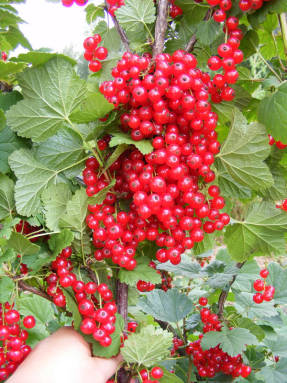
- Natalie... Medium ripening red currant variety, obtained at VSTISP. The bush is medium-sized, slightly spreading, dense. Berries are medium and large, round, slightly elongated towards the base, refreshing sweet and sour taste, universal use. The variety is fruitful, winter-hardy, characterized by high field resistance to pests and diseases.
- Marmalade... Red currant variety of very late ripening, obtained at VNIISPK. The bush is of medium height, semi-spreading, dense. Berries are medium and large, flat-round, have high gelling properties, sour taste. The variety is winter-hardy, productive, resistant to powdery mildew and anthracnose.
 |
Photo by the author


